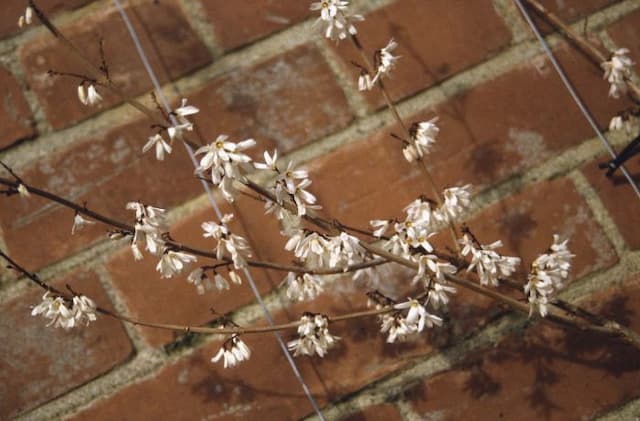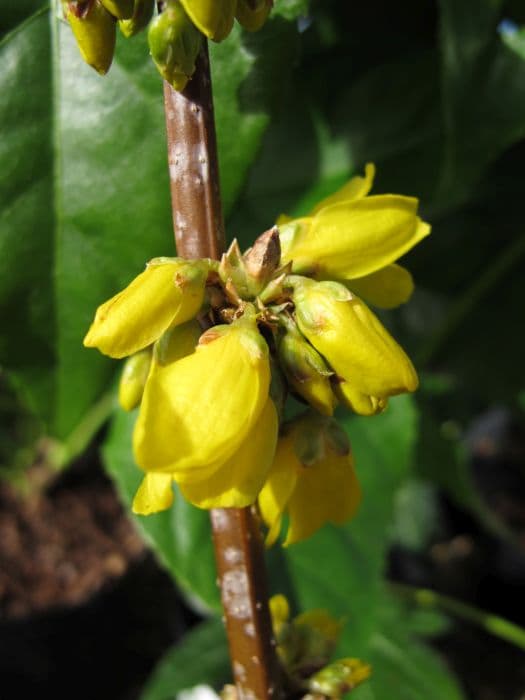Lilac 'Audrey' Syringa × prestoniae 'Audrey'

ABOUT
'Audrey' is a large, dense, deciduous shrub to 4m tall and wide with large oval leaves. Small, scented, lilac-pink, tubular flowers are held in large, upright or drooping sprays in summer
About this plant
 Names
NamesFamily
Oleaceae.
Synonyms
Audrey Preston Lilac, Preston Lilac.
Common names
Syringa × prestoniae 'Audrey'.
 Characteristics
CharacteristicsLife cycle
Perennials
Foliage type
Deciduous
Color of leaves
Green
Flower color
Pink
Height
6-8 feet (1.8-2.4 meters)
Spread
5-7 feet (1.5-2.1 meters)
Plant type
Shrub
Hardiness zones
3
Native area
Cultivar
Benefits
 General Benefits
General Benefits- Ornamental Appeal: 'Audrey' adds aesthetic value to landscapes with its showy, fragrant flowers that bloom in late spring.
- Drought Tolerance: Once established, the plant has a moderate tolerance for drought, making it suitable for gardens in drier climates.
- Cold Hardiness: It is resistant to cold temperatures, enabling it to thrive in cooler climates and survive harsh winters.
- Pollinator Attraction: The flowers attract butterflies, bees, and other pollinators, supporting local ecosystems.
- Low Maintenance: Requires minimal care once established, making it a convenient choice for both novice and experienced gardeners.
- Deer Resistance: The plant is not particularly appealing to deer, reducing the risk of damage from grazing.
 Medical Properties
Medical PropertiesThis plant is not used for medical purposes.
 Air-purifying Qualities
Air-purifying QualitiesThis plant is not specifically known for air purifying qualities.
 Other Uses
Other Uses- The dried flowers of Preston Lilac 'Audrey' can be used in potpourri to add a subtle, sweet fragrance to your home.
- The wood from pruned branches can be utilized in small woodworking projects due to its fine grain and light weight.
- During the blooming season, Preston Lilac 'Audrey' flowers can be floated in bowls of water as a decorative and fragrant centerpiece.
- The blossoms can be pressed and included in homemade paper for an artistic touch with visible flower remnants.
- Artists may use the natural dye extracted from the flowers to create a soft purple hue in their work.
- The blooming plant can serve as a natural backdrop or setting for outdoor photography, especially in spring-themed photoshoots.
- Fallen petals can be collected and used for creating naturally scented sachets to freshen up drawers and closets.
- Insect-repelling properties of the flowers can be researched and potentially utilized in gardens to deter certain pests.
- Preston Lilac 'Audrey' can be used in educational settings, like schools or botanical gardens, to teach about plant breeding and hybridization.
- Its dense foliage can provide a natural privacy screen or windbreak in residential garden design.
Interesting Facts
 Feng Shui
Feng ShuiThe Preston Lilac is not used in Feng Shui practice.
 Zodiac Sign Compitability
Zodiac Sign CompitabilityThe Preston Lilac is not used in astrology practice.
 Plant Symbolism
Plant Symbolism- Renewal and Fresh Beginnings: Like many other plants that bloom in spring, the Syringa × prestoniae 'Audrey', commonly known as Preston Lilac, often symbolizes the idea of renewal or starting anew as it flowers in a season associated with the end of winter and the beginning of life anew.
- Innocence: The delicate blooms of the Preston Lilac are commonly associated with the purity and innocence often found in the very young or in new relationships.
- First Emotions of Love: Preston Lilac's engaging fragrance and attractive flowers are often symbolic of the first stirrings of love or young love. It's a representation of the sweet and intoxicating emotions that come with new romantic encounters.
- Nostalgia and Memories: Lilacs, in general, are often tied to nostalgia or the remembrance of past loves and events. They can evoke the comforting memories of home and childhood.
 Water
WaterThe Preston Lilac 'Audrey' should be watered deeply to encourage root development, providing about 1 inch of water once a week during the growing season. In periods of drought or extreme heat, increase watering to twice a week. Allow the top inch of soil to dry out between waterings to avoid overwatering. Adjust the frequency during fall to every two weeks, and during winter, water sparingly, only enough to prevent the soil from completely drying out, as the plant is dormant during this time.
 Light
LightPreston Lilac 'Audrey' thrives best in full sun, meaning at least 6 hours of direct sunlight per day. It can tolerate partial shade, but flowering may be reduced in less than optimal sunlight. The ideal spot is where the plant will receive unfiltered morning sunlight and some afternoon shade to protect it from the intense heat.
 Temperature
TemperaturePreston Lilac 'Audrey' can withstand a range of temperatures, surviving winters down to -30 degrees Fahrenheit. The plant prefers the temperate climate with winter chill for dormancy, and the ideal growing temperatures are between 60 and 75 degrees Fahrenheit during the growing season.
 Pruning
PruningPrune Preston Lilac 'Audrey' immediately after blooming to shape the plant and remove spent flowers, which encourages better blooms for the following year. Pruning should be done annually, remembering to remove any dead or diseased branches, as well as to thin out overcrowded areas to improve air circulation.
 Cleaning
CleaningAs needed
 Soil
SoilPreston Lilac 'Audrey' thrives in well-draining, fertile loam with a neutral to slightly alkaline pH of 6.5 to 7.5. A mix of garden soil, compost, and perlite or vermiculite is ideal to ensure good drainage and nutrient availability.
 Repotting
RepottingPreston Lilacs generally do not need frequent repotting as they are outdoor shrubs. They may require transplanting every few years if they outgrow their space or if soil conditions deteriorate.
 Humidity & Misting
Humidity & MistingPreston Lilac 'Audrey' is tolerant of a wide range of humidity levels and does not require specific humidity conditions, as it is well-suited to outdoor environments where it can adapt to local conditions.
 Suitable locations
Suitable locationsIndoor
Provide bright light, cool temps, and good air circulation.
Outdoor
Plant in sun, well-draining soil, water regularly.
Hardiness zone
3-7 USDA
 Life cycle
Life cyclePreston Lilac 'Audrey' begins its life cycle as a seed, although in cultivation, it is often propagated from cuttings or grafts to maintain specific hybrid characteristics. After germination or rooting, the seedling or cutting enters a vegetative growth stage, developing roots, stems, and leaves. As the plant matures, it enters a period of budding in the spring, where flower buds form and bloom into fragrant purple or violet flowers, typically seen in late spring to early summer. Following pollination, which can be facilitated by insects like bees and butterflies, the flowers develop into seed capsules if conditions permit. Once mature, these seeds can be dispersed by wind or wildlife, continuing the reproductive cycle. The plant then goes through a period of senescence in the fall where it prepares for dormancy during the cold winter months before the cycle begins anew in the spring.
 Propogation
PropogationPropogation time
Spring-Early Summer
The most common method of propagating Syringa × prestoniae 'Audrey', also known as Preston lilac, is through softwood cuttings. This process typically takes place in late spring to early summer when new growth is still tender and green. To propagate by this method, a gardener would cut a 4 to 6 inch (about 10 to 15 centimeters) portion of a healthy stem, ensuring that there are at least a couple of leaves or leaf nodes present. The cutting's lower leaves are removed, and the cut end is then dipped in rooting hormone to encourage root development. The stem is planted in a soilless potting mix, kept moist, and placed in indirect light until roots have formed, which can take several weeks. After rooting, the new Preston lilac plantlet can be gradually acclimated to outdoor conditions before being transplanted into the garden.








